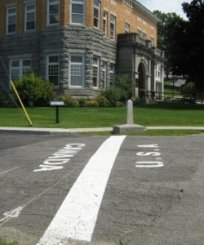November 10, 2015

National Public Safety Telecommunications Council
Portable and Mobile Radio Use at the International Border with Canada
When are you allowed to use your radio?
When are you allowed to use your radio?
First responders require constant access to mission critical voice and data communications and utilize their mobile and portable radios to communicate with the dispatch center and with other public safety personnel. The need for immediate voice and data access does not stop at the U.S. border with Canada.
Law enforcement, fire, and EMS units in the U.S. must be able to communicate with each other and with other public safety agencies responding to the scene, including first responders from Canada.

A treaty between the U.S. and Canada signed in 1951 and ratified in 1952 allows public safety agencies to operate their mobile radios as they approach the border and to continue using their mobile radio after they have crossed into the other country. This treaty did not specifically authorize the use of portable radios and was also silent on the need for data devices.
On October 8, 2014, the U.S. Federal Communications Commission (FCC) and Industry Canada (IC) signed a letter of intent which clarifies the implementation of the treaty. Both countries have acknowledged that public safety agencies may also use portable radios at the border and across the border in the other country.
This Cross Border Outreach document created by NPSTC and the Canadian Interoperability Technology Interest Group (CITIG) explains exactly what the treaty allows in simple, concrete terms and provides website addresses for further information.
The FCC and IC have also reaffirmed their joint decision to not require the issuance of a federal permit or other authorization to a public safety radio user who needs to use their licensed frequency across the border. This permitting process was provided for in the 1952 treaty at the discretion of either country and has never been implemented.
Section 90.421 of FCC rules allows U.S. public safety agencies to grant permission for Canadian first responder units to access their radio systems. State and local public safety agencies in the U.S. who allow Canadian public safety units onto their radio channels should document their approval for such access.

Join Us on Social Media









